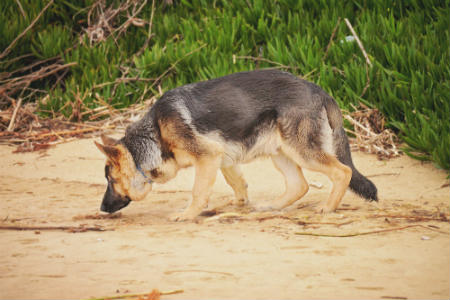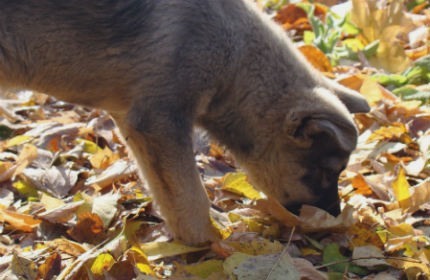The sense of smell is the most developed in dogs , it is up to 10,000 times more sensitive than their sense of taste and much sharper than their vision. If we compare it with that of human beings, they leave us far behind. Dogs have between 200 and 300 million olfactory receptors, compared to the five million that we may have. These receptors are distributed in your nose lining the mucosa, which is highly folded, thus increasing the receptor surface.

Furthermore, comparing ourselves based on the brain area dedicated to smell, in dogs it is 40 times larger than in humans. This great quality of our good furry friends has been used to carry out different activities in which you have to have a good sense of smell to guide you.
Importance of smell for dogs
It is said that dogs "see" through their nose due to their sensitivity to distinguishing smells . This sensitivity is given by the presence of an organ located in the nose, on the vomer bone, called Jacobson's organ . This organ is present in many vertebrate animals, but in dogs its functioning is particularly important to allow them to extract odors from the air. The particles that make up odors represent traces that can be followed by a dog even though they have been expelled some time ago.

Smells also help our good friends orient themselves and communicate. The great olfactory capacity they have means that they develop an olfactory memory that allows them to remember objects, people, places and other animals by their smell, along with the vision they have of them. They would even find their owner in the middle of a stadium full of people just because of the unique scent trace they can pick up! But not everything is rosy for dogs' noses. Due to their high sensitivity, there are some odors that may be unbearable for them. The smell of citrus can cause irritation in the respiratory tract, vinegar, spices, nail polish, cleaning products, sprays and even perfumes can be unpleasant and even unbearable for dogs.
How does dogs' sense of smell help us?
hunting dogs
Dogs have been, par excellence, our great companions in various daily or sporting activities, in which their olfactory capacity is their best quality . Of course, one of the best-known activities we do with dogs is hunting. And there are enormous differences between breeds and even between litters in terms of their olfactory ability.

But a good sense of smell does not always indicate a good adventure companion. Also the disposition to search for prey must complement the sense of smell to select the best specimen to do the job. The breed of dog best valued for hunting, worthy even of a king, is the Bloodhound. Many of its physical characteristics make this dog ideal for tracking: its fine sense of smell in a nose with large, very open nostrils; its long ears, which allow it to "collect" the smell from the ground and carry it upwards; and the fur on the neck and head loose enough to trap and retain odors.
shepherd dogs
Sheepdogs from different types of flocks are another example of help in which they have accompanied us in our daily lives. Dogs use their sense of smell not only to recognize members of the flock, but also to detect the presence of predators. Sheepdogs are usually intelligent, agile animals, with a great capacity for learning and solving problems.
unforeseen situations.
The herding dog par excellence is the
Border Collie , which is almost "designed" for that job. It is an intelligent and agile dog, which requires constant movement in open spaces. Attentive and affectionate with his owner, he is always willing to do the work entrusted to him.
truffle dogs
And since dogs can be trained to distinguish a particular characteristic smell, they also help us improve our culinary art. Dogs can be trained to look for different types of mushrooms, in addition to the highly valued truffle. The so-called
truffle dogs spend a large amount of time walking and sniffing a field in search of the smell given off by a truffle found underground. Once they find it, they begin to dig at the site until the owner arrives to harvest it.

Bloodhounds and also the Labrador Retriever have traditionally been used to search for truffles, but any dog can be trained for this activity . However, you must meet certain conditions to do this type of work: have a good sense of smell, of course; be very obedient and not get lost; calm, but in good physical shape to spend many hours in the field sniffing and moving from one place to another.
Police and search and rescue dogs
Their infallible sense of smell is widely used for the detection of drugs and explosives. It is almost impossible to outwit the olfactory capacity of a dog well trained for these tasks . They can distinguish between a wide variety of drugs and even detect stashes of paper money. Furthermore, whenever a tragedy happens, they are the first ones we see doing an almost frantic search to detect any trace of life. Their ability to distinguish a certain smell among many others has allowed them to be the great heroes in rescuing people buried in an earthquake or kidnapping victims. The Golden Retriever, the German Shepherd and the Belgian Shepherd are some of the most used breeds.

Visit the next post on our blog to learn more about police dogs.
Detecting diseases
Recently, studies have begun to see how to
train dogs' sense of smell to detect diseases . Positive results have been obtained detecting prostate cancer through the smell of patients' urine. Work has also been done with diabetic patients and the dog has been able to detect a hypoglycemic attack even before it occurs.
You can also read about other breeds here:


















